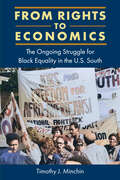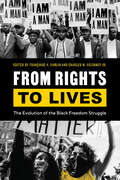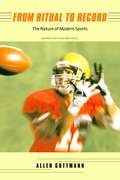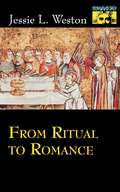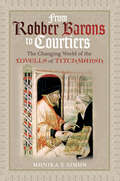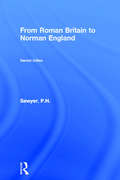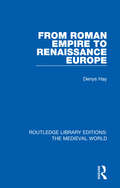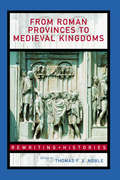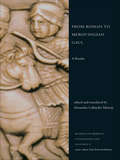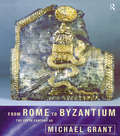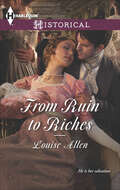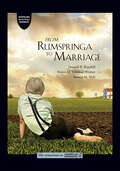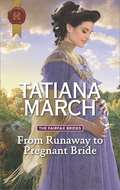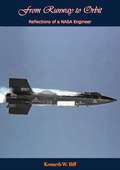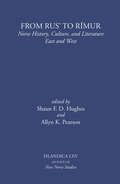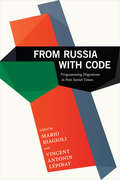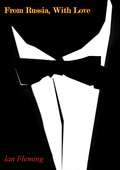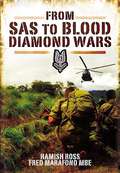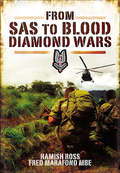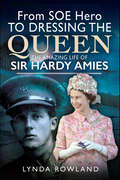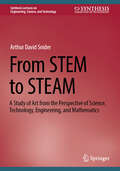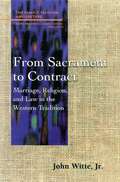- Table View
- List View
From Rights to Economics: The Ongoing Struggle for Black Equality in the U.S. South (New Perspectives on the History of the South)
by Timothy J. MinchinExamining the African American struggle for economic parity in the South after the 1960sRich with the voices of Black and white southern workers, From Rights to Economics shows how African Americans have continued fighting for economic parity in the decades since the civil rights legislation of the 1960s.Using oral histories and case studies that focus on Black activism throughout the entire South, award-winning historian Timothy Minchin examines the work of grassroots groups—including the Southern Regional Council and the NAACP Legal Defense Fund—who struggled with the economic dimensions of the movement.While white workers and managers resisted integration, activists' efforts gradually secured a wider range of job opportunities for Black people. Minchin shows, however, that the decline of manufacturing industry in the South has been especially difficult for the African American community, wiping out many good jobs just as Black people were gaining access to them.Minchin also offers a detailed discussion of a major school integration battle in Louisville, Kentucky, and examines the role of affirmative action in the ongoing Black struggle.A volume in the series New Perspectives on the History of the South, edited by John David Smith
From Rights to Lives: The Evolution of the Black Freedom Struggle (Black Lives and Liberation)
by David Mason Aram Goudsouzian Scott Brooks Mickell Carter Charity Clay Althea Legal-Miller Peter Pihos Christopher Ringer Kishauna SoljourBroadly speaking, the traditionally conceptualized mid-twentieth-century Civil Rights Movement and the newer #BlackLivesMatter Movement possess some similar qualities. They both represent dynamic, complex moments of possibility and progress. They also share mass-based movement activities, policy/legislative advocacy, grassroots organizing, and targeted media campaigns. Innovation, growth, and dissension—core aspects of movement work—mark them both. Crucially, these moments also engender aggressive, repressive, multilevel responses to these assertions of Black humanity.From Rights to Lives critically engages the dynamic relationship between these two moments of liberatory possibility on the Black Freedom Struggle timeline. The book&’s contributors explore what we can learn when we place these moments of struggle in dialogue with each other. They grapple with how our understanding of the postwar moment shapes our analysis of #BLM and wherein lie the discontinuities, in order to glean lessons for future moments of insurgency.
From Ritual to Record: The Nature of Modern Sports
by Allen GuttmannOriginally published in 1978, From Ritual to Record was one of the first books to recognize the importance of sports as a lens on the fundamental structure of societies. In this reissue, Guttmann emphasizes the many ways that modern sports, dramatically different from the sports of previous eras, have profoundly shaped contemporary life.
From Ritual to Record: The Nature of Modern Sports, updated edition
by Allen GuttmannOriginally published in 1978, From Ritual to Record was one of the first books to recognize the importance of sports as a lens on the fundamental structure of societies. In this reissue, Guttmann emphasizes the many ways that modern sports, dramatically different from the sports of previous eras, have profoundly shaped contemporary life.
From Ritual to Romance
by Jessie L. WestonAn examination and investigation of the Arthurian legends and "the Grail Problem."
From Ritual to Romance (Mythos: The Princeton/Bollingen Series in World Mythology #137)
by Jessie L. WestonAcknowledged by T. S. Eliot as crucial to understanding "The Waste Land," Jessie Weston's book has continued to attract readers interested in ancient religion, myth, and especially Arthurian legend. Weston examines the saga of the Grail, which, in many versions, begins when the wounded king of a famished land sees a procession of objects including a bleeding lance and a bejewelled cup. <P><P>She maintains that all versions defy uniform applications of Celtic and Christian interpretations, and explores the legend's Gnostic roots. Drawing from J. G. Frazer, who studied ancient nature cults that associated the physical condition of the king with the productivity of the land, Weston considers how the legend of the Grail related to fertility rites--with the lance and the cup serving as sexual symbols. She traces its origins to a Gnostic text that served as a link between ancient vegetation cults and the Celts and Christians who embellished the story. Conceiving of the Grail saga as a literary outgrowth of ancient ritual, she seeks a Gnostic Christian interpretation that unites the quest for fertility with the striving for mystical oneness with God.
From Robber Barons to Courtiers: The Changing World of the Lovells of Titchmarsh
by Monika E. SimonFrancis Lovell is without a doubt the most famous - if not the only famous - Lovell of Titchmarsh. In 1483 he was he was made a viscount by Edward IV, the first Lovell to be raised into the titled nobility. He is most famous for being the chamberlain and close friend of Richard III, the 'dog' of William Collingbourne's famous doggerel. Though Francis Lovell is the best known member of his family, the Lovells were an old aristocratic family, tracing their roots back to eleventh-century Normandy. Aside from the Battle of Hastings, a Lovell can be found at virtually all important events in English history, whether it was the crusade of Richard I, the Battle of Lewes, the siege of Calais, the Lambert Simnel rebellion against Henry VII, or the downfall of Anne Boleyn. Over the centuries the Lovells rose in wealth and power through service to the crown, rich marriages, and, to a considerable degree, luck. The history of the Lovells of Titchmarsh, from their relatively obscure beginnings in the border region between France and Normandy to a powerful position at the royal court, not only illustrates the fate of this one family but also throws an interesting light on the changes and developments in medieval and Tudor England. Several themes emerge as constant in the lives of an aristocratic family over the five centuries covered in this book: the profit and perils of service to the crown, the influences of family tradition and personal choice, loyalty and opportunism, skill and luck, and the roles of women in the family.
From Roman Britain to Norman England
by P.H. SawyerThis revised edition of the classic text of the period provides both the student and the specialist with an informative account of post-Roman English society.After a general survey of the main developments from the fourth century to the eleventh, the book offers analysis of:* social organization* the changing character of kingship, of royal government and the influence of the church* the history of settlement* the making of the landscape* the growth of towns and trade* the consequences of the Norman Conquest.The author also considers the various influences; British, Frankish, Viking and Christian that helped shape English society and contributed to the making of a united kingdom.
From Roman Empire to Renaissance Europe (Routledge Library Editions: The Medieval World #20)
by Denys HayOriginally published in 1953 From Roman Empire to Renaissance Europe looks at the broader picture of the Middle Ages, drawn in terms of the men and women and the situations that they had to face. The constant theme of change is revealed not by detailed narrative of elements but by commentary and examples that show how ideas and systems developed, and how theses affected the patterns of everyday life. The book looks at how the Roman Empire of the West gave way to a decentralized society, vigorous, brutal and inventive for which the only unifying factor was a universal acceptance of Latin Christianity. In turn Christendom began to lose its coherence during the 13th and 14th centuries and by the fifteenth century Europe had emerged as a rival term, a Europe in which the landed magnates had capitulated to the omnipotent and ubiquitous prince, commerce, as well as land now being a source of wealth. This is not a static picture of the ‘Middle Ages’ with fixed characteristics, but of real men and women facing genuine situations.
From Roman Provinces to Medieval Kingdoms (Rewriting Histories)
by Thomas F.X. NobleThis prestigious collection of essays by leading scholars provides a thorough reassessment of the medieval era which questions how, when and why the Middle Ages began, and how abruptly the shift from the Roman Empire to Barbarian Europe happened. Presenting the most current work including newly-available material such as translations of French and German essays, From Roman Provinces to Medieval Kingdoms gathers the key thinkers in the field together in one easy-to-use volume. Examining a wealth of material on the origins of the Barbarian people and their tribes, Thomas F.X. Noble studies the characteristics of the tribes and debates whether they were blood-tied clans or units bound by social, political and economic objectives. Highly readable and student friendly, From Roman Provinces to Medieval Kingdoms includes a general introduction, clear prologues to each section and makes the key debates of the subject accessible to students.
From Roman to Merovingian Gaul: A Reader (Readings In Medieval Civilizations And Cultures Ser. #5)
by Alexander Callander MurrayIncluding such remarkable accounts as Attila the Hun's meeting with the Pope, Queen Balthild's life, and Gregory of Tours' vivid descriptions of what happens when daily life is enmeshed with politics, From Roman to Merovingian Gaul documents events that are both remarkable in themselves and that demonstrate what made this era of history distinct.
From Rome to Byzantium: The Fifth Century AD
by Michael GrantByzantium was dismissed by Gibbon, in the Decline and Fall of the Roman Empire,and his Victorian successors as a decadent, dark, oriental culture, given up to intrigue, forbidden pleasure and refined cruelty. This great empire, founded by Constantine as the seat of power in the East began to flourish in the fifth century AD, after the fall of Rome, yet its culture and history have been neglected by scholars in comparison to the privileging of interest in the Western and Roman Empire. Michael Grant's latest book aims to compensate for that neglect and to provide an insight into the nature of the Byzantine Empire in the fifth century; the prevalence of Christianity, the enormity and strangeness of the landscape of Asia Minor; and the history of invasion prior to the genesis of the empire.Michael Grant's narrative is lucid and colourful as always, lavishly illustrated with photographs and maps. He successfully provides an examination of a comparatively unexplored area and constructs the history of an empire which rivals the former richness and diversity of a now fallen Rome.
From Ruin to Riches
by Louise AllenA woman on the run finds safety by entering a marriage of convenience with a wealthy nobleman in this suspenseful Regency romance.A lord in want of a wife . . .Ruined and on the run, Julia Prior is in desperate straits when she meets a gentleman with a shocking proposal. Certain he is close to death, William Hadfield, Lord Dereham, sees Julia as the perfect woman to care for his beloved estate when he is gone—if she will first become his wife. Marriage is Julia’s salvation—as Lady Hadfield, she can finally escape her sins. Until three years later, when the husband she believes to be dead returns, as handsome and strong as ever and intent on claiming the wedding night they never had!
From Rumspringa to Marriage: An Excerpt from The Amish
by Steven M. Nolt Donald B. Kraybill Karen M. Johnson-WeinerHopkins Digital Shorts deliver high-quality scholarship and compelling narratives in an abbreviated, electronic format. Whether excerpted from forthcoming or classic backlist titles or developed with newly commissioned content, Hopkins Digital Shorts provide concise introductions to fundamental concepts, defining moments, and influential texts.Rumspringa, literally translated as "running around," is a time when Amish youth socialize with their peers and are allowed some autonomy before officially joining the church as young adults. It has become one of the most recognized aspects of Amish life, both real and mythologized. During this time they face the two most crucial decisions of their lives: whether to join the church, and if and whom to marry. Rumspringa, an exciting adventure and at times a period of inner turmoil, commences at age sixteen—or seventeen in more traditional groups—and continues until marriage. With few exceptions, adolescents eagerly count the days until they are old enough to join the young folks. In this digital short, Kraybill considers the nuances of this important rite of passage into Amish adulthood.
From Runaway to Pregnant Bride
by Tatiana MarchCarrying her rescuer's baby! Annabel Fairfax fled West in disguise to find her sisters. But on her way a threat catches up with her-and she's forced to turn to a ruggedly handsome stranger on horseback! Clay Collier, her reluctant protector, tries to keep his distance from the beautiful runaway-but neither can resist one stolen night! Honor demands he marry her, but discovering Annabel's affluent background convinces Clay she doesn't belong in his dangerous world. Except his forbidden bride is already secretly pregnant...
From Runway to Orbit: Reflections of a NASA Engineer
by Kenneth W. Iliff Curtis L. PeeblesIn this remarkable memoir, Dr. Kenneth W. Iliff—the recently retired Chief Scientist of the NASA Dryden Flight Research Center—tells a highly personal, yet a highly persuasive account of the last forty years of American aeronautical research. His interpretation of events commands respect, because over these years he has played pivotal roles in many of the most important American aeronautics and spaceflight endeavors. Moreover, his narrative covers much of the second half of the first 100 years of flight, a centennial anniversary being celebrated this year.Dr. Iliff’s story is one of immense contributions to the nation’s repository of aerospace knowledge. He arrived at the then NASA Flight Research Center in 1962 as a young aeronautical engineer and quickly became involved in two of the seminal projects of modern flight, the X-15 and the lifting bodies. In the process, he pioneered (with Lawrence Taylor) the application of digital computing to the reduction of flight data, arriving at a method known as parameter estimation, now applied the world over. Parameter estimation not only enabled researchers to acquire stability and control derivatives from limited flight data, but in time allowed them to obtain a wide range of aerodynamic effects. Although subsequently involved in dozens of important projects, Dr. Iliff devoted much of his time and energy to hypersonic flight, embodied in the Shuttle orbiter (or as he refers to it, the world’s fastest airplane). To him, each Shuttle flight, instrumented to obtain a variety of data, represents a research treasure trove, one that he has mined for years.This book, then, represents the story of Dr. Ken Iliff’s passion for flight, his work, and his long and astoundingly productive careen. It can be read with profit not just by scientists and engineers, but equally by policy makers, historians, and journalists wishing to better comprehend advancements in flight during the second half of the twentieth century.
From Rus' to Rímur: Norse History, Culture, and Literature East and West (Islandica #65)
by Hughes, Shaun F. D., and Allyn K. Pearson, eds.From Rus' to Rímur, volume 65 in the Islandica series and simultaneously an issue in the occasional journal New Norse Studies, offers six contributions that range across Europe from East to West and across three categories: "Historical Studies," "Literary Studies," and "New Editions." The volume opens with a historical-onomastic study of the Varangian presence in Medieval Rus' and proceeds to the Isle of Man for a consideration of its population's "ethnogenesis" in the tenth and eleventh centuries. Literary studies and fresh translations follow to return our attention to the remarkable creativity in sagas and poetry that was an especially rich province of Norse and Icelandic culture. Contributors: Matthew Bardowell, Brynja orgeirsdóttir, Francesco Colombo, Caitlin Ellis, Eric A. Haley-Halinski, Shaun F. D. Hughes, Jonathan Y. H. Hui, Philip Lavender, Anna Litvina, James McIntosh, Dirk H. Steinforth, Fjodor Uspenski.
From Russia to the West: The Musical Memoirs and Reminiscences of Nathan Milstein
by Antonina W. Bouis Nathan Milstein Solomon Volkov1. Childhood in Odessa I was born in Odessa, a beautiful and gay city on the Black Sea, in the south of the Russian empire. I grew up a hellion. I would run outside, shout, fight with other kids, then save myself by running home. It wasn't very brave or risky on my part, but Mother worried about me anyway. A neighbor in our building, Mrs. Roisman, gave advice: "You have to keep Nathan busy! Let him take music lessons!"
From Russia with Code: Programming Migrations in Post-Soviet Times
by Mario Biagioli Vincent Antonin LépinayWhile Russian computer scientists are notorious for their interference in the 2016 US presidential election, they are ubiquitous on Wall Street and coveted by international IT firms and often perceive themselves as the present manifestation of the past glory of Soviet scientific prowess. Drawing on over three hundred in-depth interviews, the contributors to From Russia with Code trace the practices, education, careers, networks, migrations, and lives of Russian IT professionals at home and abroad, showing how they function as key figures in the tense political and ideological environment of technological innovation in post-Soviet Russia. Among other topics, they analyze coders' creation of both transnational communities and local networks of political activists; Moscow's use of IT funding to control peripheral regions; brain drain and the experiences of coders living abroad in the United Kingdom, United States, Israel, and Finland; and the possible meanings of Russian computing systems in a heterogeneous nation and industry. Highlighting the centrality of computer scientists to post-Soviet economic mobilization in Russia, the contributors offer new insights into the difficulties through which a new entrepreneurial culture emerges in a rapidly changing world. Contributors. Irina Antoschyuk, Mario Biagioli, Ksenia Ermoshina, Marina Fedorova, Andrey Indukaev, Alina Kontareva, Diana Kurkovsky, Vincent Lépinay, Alexandra Masalskaya, Daria Savchenko, Liubava Shatokhina, Alexandra Simonova, Ksenia Tatarchenko, Zinaida Vasilyeva, Dimitrii Zhikharevich
From Russia, With Love (Modern Classics Ser.)
by Ian FlemingMURDER ON THE ORIENT EXPRESSThe Russians wanted to liquidate James Bond—ace British secret agent—in a way that would embarrass England. So they lined up their best team to pull off the job!Tatiana Romanova—an alluring brunette seductress who looks like Garbo although her heart belongs to the State.Red Grant—a renegade Irish hired assassin, who likes to kill for kicks.Rosa Klebb—head of Otydel II, department of torture and death, a hideous woman with a lust for inflicting excruciating torment.The master conspirators devise a trap designed to eliminate Bond on a perilous journey from Istanbul to Paris via the lush Orient Express. A trip on which Bond makes passionate love to one of his captors as he fights desperately to protect his life from the others, while the train speeds towards its ultimate, awful rendezvous with death!JAMES BOND becomes the target of theRUSSIAN MURDER ORGANIZATION, SMERSH…The deadly and sinister SMERSH sets a trap to catch and kill James Bond, ace British spy with a weakness for women and wine, and they bait it with a beautiful brunette. But they don’t count on her falling in love with her victim…after she has seduced him!!“One of the most outrageously entertaining thrillers ever contrived.”—New York World Telegram and Sun.
From SAS to Blood Diamond Wars
by Hamish Ross Fred Marafono<p>On the point of being demobbed from the SAS, Fred Marafono was recruited by David Stirling for his private security company. After Stirling’s death, Fred found himself in the midst of Sierra Leone’s Blood Diamond wars, and formed an unbreakable bonding with the country’s champion of democracy, Chief Hinga Norman, whose leadership and tragic death are integral to the story. <p>Fred was recruited by Simon Mann for the finest of all private military companies in Africa, Executive Outcomes. Fewer than two hundred of them defeated the rebels in their strongholds. Through political weakness, Executive Outcomes were made to leave the country, and chaos ensued. Committed men like Hinga Norman and British High Commissioner Peter Penfold saw that in the absence of military commitment from the west, only high caliber mercenaries would win the fight to restore democracy: three of them kept a vital air bridge open − ‘What God abandoned, these defended’. Fred’s final action was supporting the SAS in their brilliant hostage release, ‘Operation Barras.’ <p>Peter Penfold sums it all up in the book’s foreword, writing of the, ‘confidence, trust and admiration I have for this remarkable man.’</p>
From SAS to Blood Diamond Wars
by Hamish Ross Fred MarafonoAlcibiades is one of the most famous (or infamous) characters of Classical Greece. A young Athenian aristocrat, he came to prominence during the Peloponnesian War (429-404 BC) between Sparta and Athens. Flamboyant, charismatic (and wealthy), this close associate of Socrates persuaded the Athenians to attempt to stand up to the Spartans on land as part of an alliance he was instrumental in bringing together. Although this led to defeat at the Battle of Mantinea in 418 BC, his prestige remained high. He was also a prime mover in Athens' next big strategic gambit, the Sicilian Expedition of 415 BC, for which he was elected as one of the leaders. Shortly after arrival in Sicily, however, he was recalled to face charges of sacrilege allegedly committed during his pre-expedition reveling. Jumping ship on the return journey, he defected to the Spartans.Alcibiades soon ingratiated himself with the Spartans, encouraging them to aid the Sicilians (ultimately resulting in the utter destruction of the Athenian expedition) and to keep year-round pressure on the Athenians. He then seems to have overstepped the bounds of hospitality by sleeping with the Spartan queen and was soon on the run again. He then played a devious and dangerous game of shifting loyalties between Sparta, Athens and Persia. He had a hand in engineering the overthrow of democracy at Athens in favor of an oligarchy, which allowed him to return from exile, though he then opposed the increasingly-extreme excesses of that regime. For a time he looked to have restored Athens' fortunes in the war, but went into exile again after being held responsible for the defeat of one of his subordinates in a naval battle. This time he took refuge with the Persians, but as they were now allied to the Spartans, the cuckolded King Agis of Sparta was able to arrange his assassination by Persian agents.There has been no full length biography of this colorful and important character for twenty years. Professor Rhodes brings the authority of an internationally recognized expert in the field, ensuring that this will be a truly significant addition to the literature on Classical Greece.
From SOE Hero to Dressing the Queen: The Amazing Life of Sir Hardy Amies
by Lynda RowlandThe biography of one of Britain’s foremost fashion designers who led a fascinating double life as a couturier and an intelligence officer during the Second World War. Sir Hardy Amies was one of Britain’s foremost fashion designers who led a fascinating double life as a couturier and an intelligence officer during the Second World War. Sir Hardy’s work for the Belgian resistance effort as part of the Special Operations Executive, was so significant that he was awarded l’Ordre de la Couronne, or Order of the Crown, by the Belgian Government in 1948. Not only did Sir Hardy conduct these operations, but he also simultaneously developed his burgeoning fashion business through the British Board of Trade’s drive to promote UK manufacturing throughout the conflict. He was a man who at once epitomized and challenged the reality of being gay in an era when society was deeply unaccepting. He was thrust into what was an overtly macho and potentially hostile environment and, against that backdrop, made a valuable and courageous contribution to the war effort. Born into what we would consider a lower middle-class family, he was handsome, cultured and gregarious and effortlessly traversed the post-war world of high society, launching his haute couture house to great acclaim, gaining clients ranging from film stars to royalty. His work for Queen Elizabeth II saw him awarded the CVO in 1977 and this was elevated to the KCVO, Knight Commander of the Victorian Order in 1989. Her Majesty’s warmth of feeling towards Sir Hardy is evident in the many hand-written thank-you letters she sent him over the course of their long working relationship. Sir Hardy, who lived until the age of 93, could have been dismissed as a lightweight character from the frivolous world of fashion. However, despite a not-particularly extensive formal education, he was highly intelligent, extremely well-traveled and spoke three languages, and his story encapsulates the extraordinary cultural and societal turbulence of the twentieth century.
From STEM to STEAM: A Study of Art from the Perspective of Science, Technology, Engineering, and Mathematics (Synthesis Lectures on Engineering, Science, and Technology)
by Arthur David SniderThis book provides readers with an introductory overview of art from the perspective of science, technology, engineering, and mathematics. The author utilizes well-known and important works of art to demonstrate how STEM concepts apply to them. The book’s examples include a structural analysis of Michelangelo’s David. The author covers major breakthroughs in art history, such as the discovery of perspective. The book also discusses other important elements of art, such as color, from a scientific point of view. The author ensures that readers will understand the art terms used by comparing them with terms used in STEM fields of study.
From Sacrament to Contract: Marriage, Religion, and Law in the Western Tradition
by John Witte Jr.In From Sacrament to Contract, John Witte Jr. offers a study of five conflicting models of marriage--Catholic, Lutheran, Calvinist, Anglican, and Enlightenment--and their social and political impact over the last thousand years. In so doing, Witte shows how we arrived at the notion of marriage as contract. The Family, Culture, and Religion series offers informed and responsible analyses of the state of the American family from a religious perspective and provides practical assistance for the family's revitalization.
